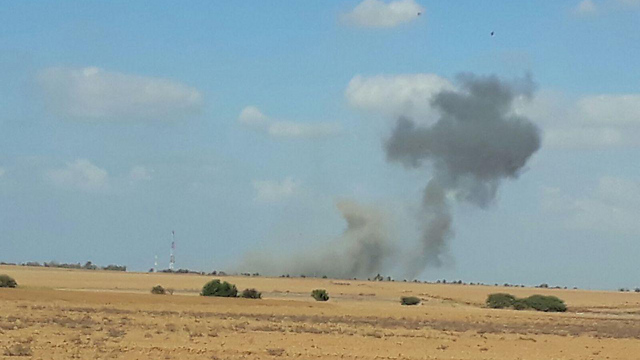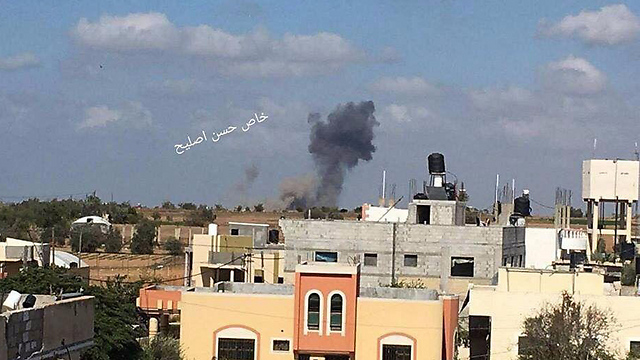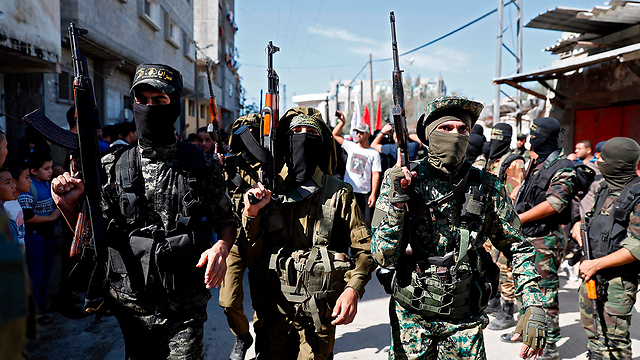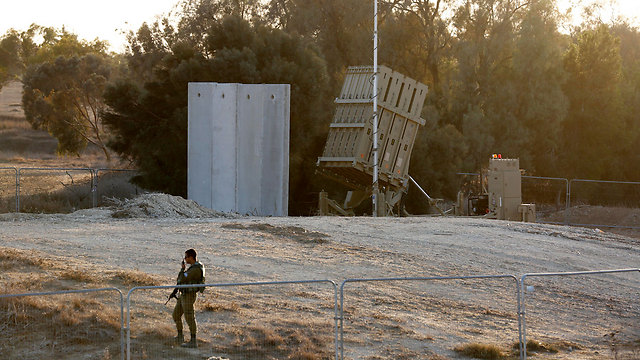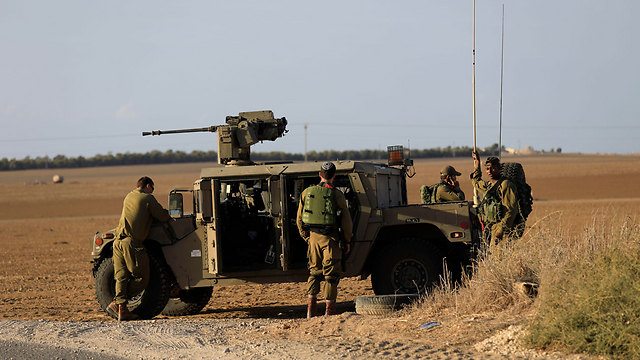

Several tunnel terrorists still missing, may be in Israel
Following detonation of Islamic Jihad tunnel running in Israeli territory Monday, IDF's Gaza Division remains on high alert as IJ may retaliate loss of 9 operatives, with 5 missing; detonation made possible thanks to 'brain'—group of engineers, geologists, others operating to locate, destroy tunnels; Iran may goad IJ to retaliate to scuttle Hamas-Fatah reconciliation.
The Palestinian Islamic Jihad (PIJ) suffered a major blow Monday, when a tunnel carrying its operatives—including senior commanders—was detonated by the IDF, killing nine terrorists with five still considered missing.
The IDF considers the incident to still be ongoing, with the Gaza Division remaining on high alert in fear of PIJ retaliatory measures following the tunnel's detonation, with the army saying it was merely 200 – 300 meters from one of its outposts in the Kissufim sector. A shaft exiting into Israeli territory was not yet excavated, the army added.
Two of the causalities in the detonation were senior Islamic Jihad figures—a brigade commander and his deputy—active in the second largest terrorist organization in the Gaza Strip, and five Jihad terrorists are still missing, possibly within Israeli territory. while Hamas operatives, part of the organization's naval commandos, went down into the tunnel to extract their wounded compatriots and were also killed.
A senior IDF Southern Command officer spoke to reporters Wednesday, saying, "We're still in the midst of this incident. We're careful to not become complacent despite the momentous achievement. We're looking at the (Hamas-Fatah) reconciliation with wariness because Hamas is trying to have its cake and eat it too, partnering with both Fatah and Iran. The reconciliation does not necessarily bode well for us, but it is an expression of the pressures Hamas is under."
IDF Southern Command presumed that apart from the search for missing operatives, which is still ongoing, PIJ is deliberating on its response, its timing and magnitude. Indeed, days may pass before the terrorist group retaliates, similarly to a January 2015 incident in which Hezbollah launched anti-tank missiles at a Givati force in Mount Dov as retaliation for Israel's purported assassination of Jihad Mughniyeh.
The Islamic Jihad, then, may bide its time and wait for the most opportune operational moment to strike back at Israel.
Some of the options the IDF has taken into consideration are a significant barrage of rockets launched at one of Israel's southern population centers, an anti-tank missile launch at the new border barrier work site, against an IDF force operating near the border or sniper shooting near the border fence. A terrorist attack somewhere in the West Bank was also deemed possible.
"The Islamic Jihad was dealt a very serious blow—perhaps deservedly so—and at any given moment it may strike back. It's a significant failure for the organization, both in its tunnel being exposed and the manner in which it chose to attempt to mount a rescue effort," the IDF officer added.
"It would be remiss in choosing to retaliate. The longer it waits, the lesser the chances for retaliation. Those operating against us will pay a heavy price, and Hamas—which we consider to be the sovereign in the strip—will also be drawn into the circle of escalation," the officer cautioned.
"Hamas is not without blame in the incident, as it allowed the tunnel to be dug in the first place. However, it currently wishes to continue the calm in order to regain its strength and concentrate on internal civilian issues. The Islamic Jihad is not bound by the same rules as Hamas and will be hard pressed not to retaliate considering the large number of casualties it suffered. If Hamas does not rein them in, it will also be drawn into the cycle of violence. Let every tunnel excavator know when they go down there: their lives are at risk," the officer concluded.
The tunnel detonated Monday was considered unique due to the organization that excavated it—the Islamic Jihad—which thus far concentrated on developing advanced rocket capabilities, occasionally better than Hamas's. The PIJ has some 10,000 fighters in the strip and has equipped itself with hundreds of medium-range rockets, reaching up to 40 kilometers, and several dozen relatively new short-range rockets, only capable of reaching the area surrounding Gaza but carrying a payload of hundreds of kilograms of explosives. The latter rockets are equivalent to Hezbollah's Burqan rockets in their destructive potential.
The organization coordinates with Hamas but is considered independent, and its stance on the reconciliation agreement has yet to become known.
Due to heightened tensions, work on the underground anti-tunnel barrier wall was partially halted in light of daily status evaluations and the danger snipers pose to the project's employees and the forces acting as their security.
The IDF also has not ruled out the possibility Iran, the organization's chief financier, will consider the new situation an opportunity to hamstring the newly-found reconciliation, brokered by Egypt, and urge PIJ to retaliate in order to create escalation within the entire strip.
"The Islamic Jihad's headquarters are in Syria, where decisions are made in coordination with Iran," the Israeli officer explained.
New discoveries regarding the detonated tunnel
New details regarding the IDF campaign against terror tunnels in the Gaza Strip came to light Wednesday, as it was discovered the Gaza Division has been operating a group of experts—dubbed "the brain" by the senior officer—for about a year, tasked with locating and destroying tunnels.The lab, which is overseen by an officer affiliated with the division, has engineers, geologists, engineering officers and intelligence personnel all working in tandem to interpret data received by the technological systems deployed in the field, including the sensor array that picked up the tunnel this week.
The tunnel was detonated as part of an operation that mobilized dozens of officers and soldiers, and the tunnel's detonation was precise thanks to the experts' efforts. The operational also entailed preliminary deployment in the sector, strengthening defenses near the border and isolating the space around the tunnel.
The laboratory was designed to operate not merely against tunnels penetrating into Israeli territory, but to also translate its innovative capabilities for the forces maneuvering around the strip during the next conflagration.
The information gleaned by "the brain" will assist soldiers in handling Hamas's many upgraded offensive tunnels, through which the organization attained one of its greatest achievement during Operation Protective Edge: kidnapping the bodies of Oron Shaul and Hadar Goldin.
Islamic Jihad excavators worked on the tunnel for about a year, and five of them were performing digs while it was detonated, which may mean the organization was unaware its tunnel was discovered and signaled for demolition by the IDF.














